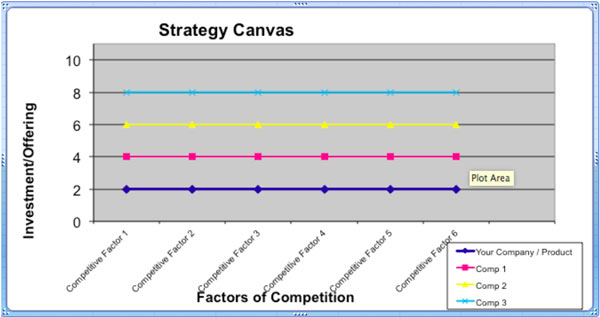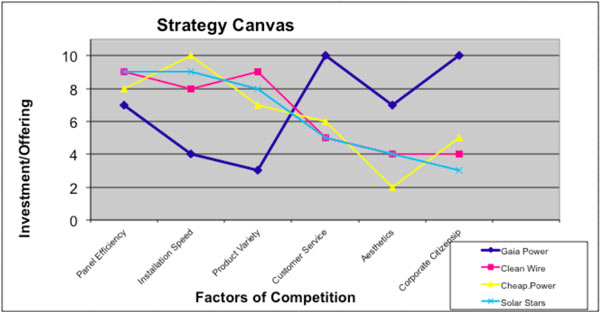The strategy canvas has become something of a go-to process to guide companies through the difficult and fraught process of strategic planning. Still, there are many companies and consultants who remain unfamiliar with the strategy canvas and the potential it offers for navigating the future. Used correctly, the strategy canvas can be a remarkably useful tool. It helps to quickly communicate the state of an industry, as well as how a company ought to strategize relative to those conditions.
In this article, we’ll give you a working understanding of the strategy canvas, including how to create one and how to implement the insights it offers.
What is Strategy Canvas?
You may still be wondering, what is a strategy canvas? The basic definition is, well, quite basic: the strategy canvas is a strategic planning tool. More specifically, it’s a visualization tool that helps companies graphically represent the state of an industry, expressed in terms of the relative investments and performance metrics of the industry’s various players.
Best-in-Class Corporate Training
Learn more about training for your team or organization
The strategy canvas concept was first introduced in the bestselling 2005 book Blue Ocean Strategy. The tool was designed to save time and provide focus in the strategic planning process. It derives from the book’s main premise, that instead of competing for elbow room in a crowded marketplace, companies would be better served carving out their own marketplace, differentiated from competition.
Strategy Canvas Template
If you’ve never seen one before, and may not understand how simple it actually is. You’re probably wondering, “how do you create a strategy canvas?” In its basic form, the strategy canvas template consists of a line graph. Along the x-axis are entries representing the various factors of competition in a particular industry. The y-axis represents the amount of investment companies make in those different factors. In turn, those factors dictate what those companies offer to customers. The various companies depicted are illustrated by the lines connecting their entries for each of the factors of competition.

In the chart above, we haven’t yet defined the factors and rated the competitors. If we started to do that, the lines would not be straight and perfectly horizontal. They would zig and zag, because competitor 2 might have a score of 10 on the first competitive factor, a score of 4 on the second, 8 on the third, etc.
You can see how quickly the strategy canvas template illustrates the ways companies are (or aren’t) differentiated in terms of where they spend money and what they offer customers. If your company and every other company achieves a score of 6 on Competitive Factor 4, this means that the area of competition is incredibly intense and undifferentiated. Everyone is investing the same amount, doing the same things, and delivering similar levels of performance.
Strategy Canvas Applications
Most companies make the same initial mistake. They see areas where other companies spend more than them and think they need to outspend and outshine their competition in every dimension. This will take you right into a crowded marketplace where all of the competition looks the same. It can be more powerful to carve out your own unique “value curve” in which you provide unique value to customers.
Sales Strategy Canvas
A sales strategy canvas looks at the various dimensions of sales investments for different competing companies. Some of the factors to include for a sales strategy canvas might be:
-
- investment in advertising
- in-person versus telephone/online sales
- whether companies are selling boilerplate products in mass quantities or customized products in smaller quantities.
Brand Strategy Canvas
A brand strategy canvas compares competitors based on the different dimensions in which companies construct their brands in the marketplace and in the minds of customers. Some of the factors that have an impact on brand reputation include:
-
- advertising
- customer demographics
- reputation for product quality
- trustworthiness
- customer service
- corporate citizenship.
Business Model Canvas Strategy
A business model canvas strategy offers a comparison of companies that offer similar products but differ in their core business models. For example, some shoe companies only sell their products online. Others sell them via third party retailers. Others operate their own stores. These different business models will dictate different amounts of investment in:
-
- inventory
- personnel
- customer service
- marketing.
Many products may be heavily represented in some business models but underrepresented in others, offering companies the chance to exploit the unfilled niche.
Example of Strategy Canvas
Let’s take a look at an example of a strategy canvas and what it can tell us.

It should be easy to see here that we’re looking at four different players in a marketplace for solar panels. We can see that Gaia Power fails to match its competition in terms of the quality & variety of its panel offerings. It also falls short when it comes to the speed of installation. However, instead of pouring extra resources into bridging that gap, Gaia Power has differentiated itself by exceeding its competitors in customer service, aesthetics, and corporate citizenship. This combination of factors may not appeal to every customer, but it will help Gaia Power stand out to a certain customer segment.
[globalcta id="CTA-CorpTraining-v1"]
Conclusion
The examples we’ve just gone through offer a good illustration of the power of the strategy canvas to encapsulate the state of an industry in the present moment. However, it is also designed to help companies move into the future by offering a clear visual representation of potential focus areas. The strategy canvas is a helpful quantitative and qualitative tool to help make clear how companies can differentiate from areas where competition is fiercer.
Additional Reading:
- Promote Job Openings to MC's >1M-strong community
- The Pyramid Principle
- Top 7 Business Frameworks to Know
- Decision Making Models
- How to Develop a Strategic Plan
- Utilizing SWOT In A Business Case